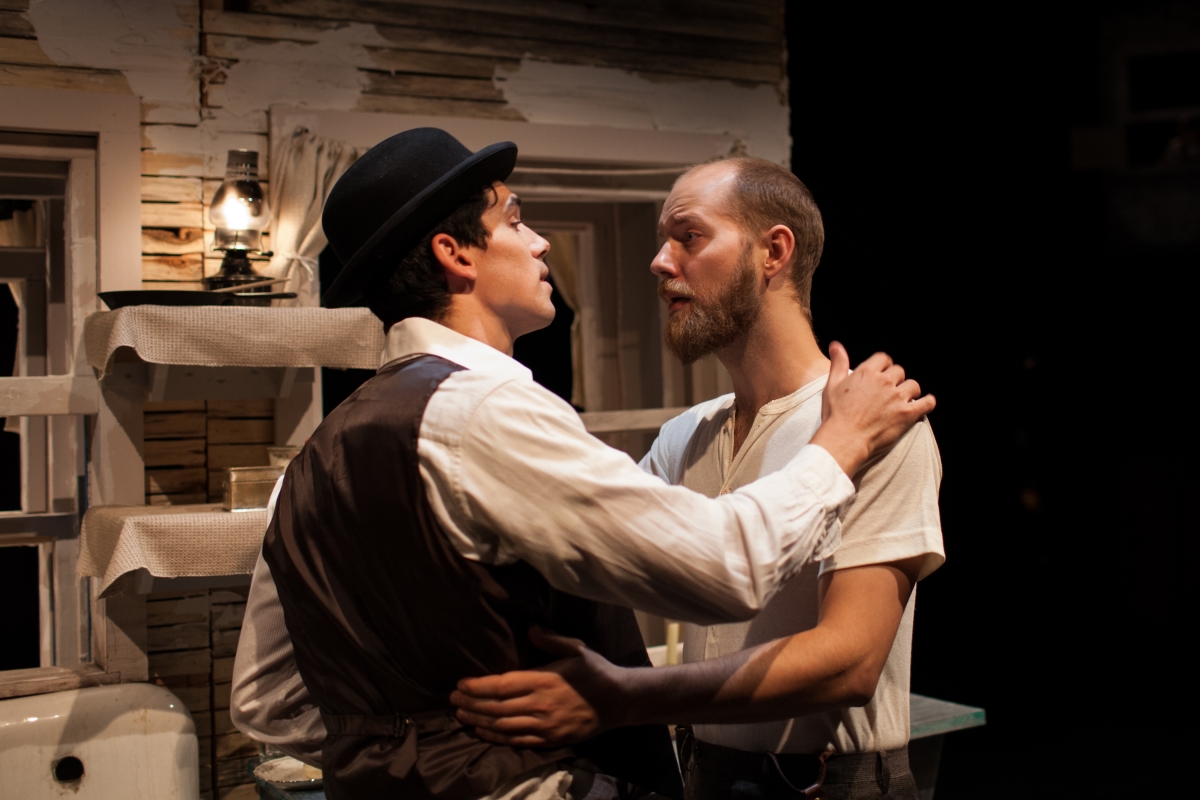
Andrew Farmer's The Gray Man sets the pre-show mood with the sound of a desolate wind, which is eventually broken by a child's voice singing about a "poor babe" stolen away and killed in the woods. Creepy little girls singing creepy songs may not be a new element of horror, but here, as throughout The Gray Man, it feels fresh and immediate. Like much good horror, Farmer's play roots itself in the familiar -- the fairy tale, the ghost story, the bedtime story -- and renders it strange and estranging. As two of the characters say, "It's many, many stories," "But it’s all one story in the end." The story of the Gray Man is framed as a story of good mothers and bad mothers, of the dangers of the world beyond a mother’s immediate reach, of the illusion of safety. It is also, to an extent, a story about storytelling, stories of and by good and bad mothers and of and by children, obedient and disobedient, safe and not so safe.
Simon Parrish (Daniel Johnsen), whose late mother kept him close "every second of every day" and who remains rather child-like himself, lives in a tenement apartment in the city with John (Shane Zeigler), a situation that Simon increasingly wants to escape, in part to start his own family (despite demonstrating something of a lack of familiarity with romantic relationships). Both Simon's present neighborhood and his familial past share a connection to (stories of) the titular Gray Man, whose mouth drips gold and who watches and whispers to children until a variety of "bad things" happen to them. Simon happens to meet 10 year-old Grace (Tahlia Ellie), who is writing her own story (she tells Simon that she sometimes needs to write things down instead of saying them), and the endings of both their narratives become inextricably intertwined.
These narratives develop in a flat room dominated on one side by Simon’s apartment set, sporting lath walls with blotches of plaster and a few windows, with some clotheslines and Grace’s window above. The audience's seats are arranged around the perimeter of the room, which allows the actors to cross the boundary into the spectators' space. The elimination of any buffer between audience and performance space works both within the narrative frame, in which the audience is being told a story by the Mothers (Katherine Lorraine and Claire Rothrock), and to increase the sense of anxiety. The production keeps both the cast and the story lean, and allows the individual characters, and the actors who play them, to shine. The cast as a whole, especially the Mothers/Laundry Women and John, accomplish with facility the sometimes tricky task of playing period (in this case, the early-20th century) without ever crossing into caricature. It is also always risky when a vital role rests on the shoulders of a child actor, especially in a play that thrives by creating tension, but Ellie is more than up to the challenge, evoking in the audience a genuine fear on her behalf.
It is perfectly possible to interpret The Gray Man's instances of leaving or losing mothers and their promise of safety and care metaphorically. But it is equally possible to simply experience the straightforward pleasures that it offers as a consummately constructed, extremely effective horror tale.This tale is dark not just in its content but in its execution: aided by live piano, it employs strikingly dramatic changes in lighting, as well as a couple of startling moments, to maintain an eerie, suspenseful atmosphere. This is the perfect show to see as we move through October, the month dedicated to all things terrifying. Ignore your mother and heed the Gray Man's whispered call. He's waiting. - Leah Richards and John Ziegler
